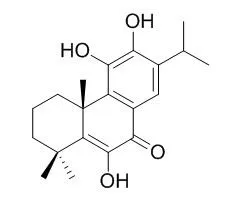| In vitro: |
| J Chem Ecol. 2010 Dec;36(12):1381-6. | | Antifungal abietane-type diterpenes from the cones of Taxodium distichum Rich.[Pubmed: 21072573] |
METHODS AND RESULTS:
The chemical composition of Taxodium distichum cones and the antifungal activities of twelve diterpenoids against two wood decay fungi, Trametes versicolor (white-rot) and Fomitopsis palustris (brown-rot) were examined. The chemical composition of the major extractive fraction, the n-C(6)H(14) extract, was evaluated and its antifungal properties were identified. Twelve diterpenoids including ten abietane-type components were isolated from the n-C(6)H(14) extract: 6,7-dehydroferruginol (1), ferruginol (2), 6,7-dehydroroyleanone (3), sandaracopimaric acid (4), taxodione (5), taxodal (6), taxodone (7), sugiol (8), xanthoperol (9), salvinolone (10), 5,6-dehydrosugiol (11), and 14-Deoxycoleon U (12). Compounds 5 and 14-Deoxycoleon U were highly active against both wood-decay fungi. In particular, the activities of these compounds against F. palustris were potent.
CONCLUSIONS:
The results suggest that the position and the number of hydroxyl groups on abietane-type structures may be related to antifungal activities against T. versicolor and F. palustris. | | J Chem Ecol. 2009 Jun;35(6):635-42. | | Antitermitic activities of abietane-type diterpenes from Taxodium distichum cones.[Pubmed: 19475449 ] |
METHODS AND RESULTS:
Eight known abietane-type diterpenes were isolated from the weak acidic fraction of the n-hexane extract from cones of Taxodium distichum, one of the extant, living fossil conifers. They were identified as 6,7-dehydroroyleanone (1), taxodal (2), taxodione (3), salvinolone (4), 14-Deoxycoleon U (5), 5,6-dehydrosugiol (6), sandaracopimaric acid (7), and xanthoperol (8). The structures of these compounds were determined by comparison of NMR spectral data with published data. The antitermitic (termicidal and antifeedant) activities of the compounds 1-8 against the subterranean termite, Reticulitermes speratus Kolbe, were evaluated.
CONCLUSIONS:
Compounds 1 and 3 showed potent termicidal activity, and 5 and 8 showed potent antifeedant activity. Compound 1 was found to be one of the representative bioactive compounds in the n-hexane extract of T. distichum cones. Compounds 1-8, with the exception of 7, were oxides of ferruginol (9). Therefore, the presence of various oxidation forms of the abietane-type structure reflects their various bioactivities. |
|






 Cell. 2018 Jan 11;172(1-2):249-261.e12. doi: 10.1016/j.cell.2017.12.019.IF=36.216(2019)
Cell. 2018 Jan 11;172(1-2):249-261.e12. doi: 10.1016/j.cell.2017.12.019.IF=36.216(2019) Cell Metab. 2020 Mar 3;31(3):534-548.e5. doi: 10.1016/j.cmet.2020.01.002.IF=22.415(2019)
Cell Metab. 2020 Mar 3;31(3):534-548.e5. doi: 10.1016/j.cmet.2020.01.002.IF=22.415(2019) Mol Cell. 2017 Nov 16;68(4):673-685.e6. doi: 10.1016/j.molcel.2017.10.022.IF=14.548(2019)
Mol Cell. 2017 Nov 16;68(4):673-685.e6. doi: 10.1016/j.molcel.2017.10.022.IF=14.548(2019)